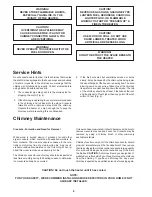
WARNING!
NEVER STORE FLAMMABLE LIQUIDS,
ESPECIALLY GASOLINE. IN THE
VICINITY OF THE HEATER.
CAUTION!
OVERFIRING THE APPLIANCE MAY
CAUSE A HOUSE FIRE. IF A UNIT OR
CHIMNEY CONNECTOR GLOWS, YOU
ARE OVERFIRING.
CAUTION!
NEVER USE GASOLINE, GASOLINE-TYPE
LANTERN FUEL, KEROSENE, CHARCOAL
LIGHTER FLUID, OR FLAMMABLE
LIQUIDS TO START OR "FRESHEN UP" A
FIRE IN THE HEATER.
CAUTION!
USE WOOD OR COAL. DO NOT USE
DRIED LUMBER, TREATED WOOD
ARTIFICIAL OR PRESSED LOGS.
WARNING!
NEVER OPERATE THIS HEATER WITH THE
FUEL DOOR OPEN.
WARNING!
DO NOT OBSTRUCT THE SPACE BENEATH
THE HEATER
Chimney Maintenance
Creosote - Formation and Need for Removal
When wood is burned slowly, it produces tar and other
organic vapors, which combine with expelled moisture to
form creosote. The creosote vapors condense in the rela-
tively cool chimney flue of a slow burning fire. As a result,
creosote residue accumulates on the flue lining. When ig-
nited this creosote makes an extremely hot fire.
The chimney connector and chimney should be inspected at
least twice monthly during the heating season to determine
if a creosote buildup has occurred.
If creosote has accumulated, it should be removed. Failure to
remove creosote may cause a house fire. Creosote may be
removed by using a chimney brush or other commonly
available materials.
Chimney fires burn very hot. If the chimney connector should
glow red, immediately call the fire department, then reduce
the fire by closing the inlet air control and pour a large quantity
of coarse salt, baking soda or cool ashes on top of the fire in
the firebox.
CAUTION:
A chimney fire may cause ignition of
wall studs or rafters which you thought were a safe distance
from the chimney. If you have a chimney fire, have your
chimney inspected by a qualified person before using again.
Service Hints
Do not expect a heater to draw. It is the chimney that creates
the draft. Smoke spillage into the house or excessive buildup
of water or creosote in the chimney are warnings that the
chimney is not functioning properly. Correct problem before
using heater. Possible causes are:
The connector pipe may push into the chimney too far,
stopping the draft. (Fig. 4)
If the chimney is operating too cool, water will condense
in the chimney and run back into the stove. Creosote
formation will be rapid and may block the chimney.
Operate the heater at a high enough fire to keep the
chimney warm preventing this condensation.
1.
2.
5.
If the fire burns well but sometimes smokes or burns
slowly, it may be caused by the chimney top being lower
than another part of the house or a nearby tree. The wind
blowing over a house or tree, falls on top of the chimney
like water over a dam, beating down the smoke. The top
of the chimney should be at least 3 feet above the roof
and be at least to 2 feet higher than any point of the roof
within 10 feet (Fig. 6).
NOTE:
FOR YOUR SAFETY, WE RECOMMEND INSTALLING SMOKE DETECTORS IN YOUR HOME IF NOT
ALREADY INSTALLED.
CAUTION! Do not touch the heater until it has cooled.
6


























